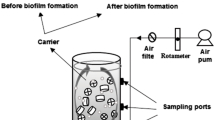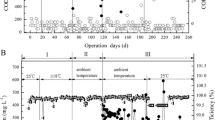Abstract
Controlling high concentrations of industrial formaldehyde pollution has become a hot issue in recent years. This problem needs to be solved, where formaldehyde, which is highly soluble in water, in biofilm packed towers led to the reduction of removal performance of the packed towers. This paper presented a new method which is based on the biofilm packed tower, a liquid-phase treatment device consisting of an aeration tank and a sedimentation tank that was added to construct a composite bioreactor system. Moreover, this study investigated the effects of the composite bioreactor on the removal of formaldehyde under different operation conditions and the structural succession characteristics of the dominant bacterial communities in the composite biological system. The results indicated that even if the operating conditions including meteorological formaldehyde concentrations at the inlet, gas flow, and circulating liquid flow were changed, the B (amount of biochemically degraded formaldehyde in waste gas per unit time in a unit volume) in the composite bioreactor was also higher than that of the blank biofilm packed tower. Also, at the genus level, the microbial community structures of the two systems were not the same, where the dominant genera of the biofilm packed tower (blank group) included Pseudomonas, Methyloversatilis, Cupriavidus, and Hyphomicrobium. After the addition of the liquid-phase treatment device, the composite bioreactor promoted three aerobic bacteria including Ensife, Acidimicrobiales_norank, and Anaerolineaceae_norank to become the dominant genera. In the two systems, the relative abundances of the formaldehyde-degrading bacteria including Pseudomonas, Methyloversatilis, Methylophilus, and Methylobacterium increased with time and gradually became stabilized.













Similar content being viewed by others
References
Aguirre, A., Bernal, P., Maureira, D., Ramos, N., Vásquez, J., Urrutia, H., et al. (2018). Biofiltration of trimethylamine in composite bioreactor inoculated with Aminobacter aminovorans. Electronic Journal of Biotechnology, 33, 63–67.
Anderson, L. G., Lanning, J. A., Barrell, R., Miyagishima, J., Jones, R. H., & Wolfe, P. (1996). Sources and sinks of formaldehyde and acetaldehyde: an analysis of Denver’s ambient concentration data. Atmospheric Environment, 30(12), 2113–2123.
Chaudhary, N., Sharma, A. K., Agarwal, P., Gupta, A., & Sharma, V. K. (2015). 16S classifier: a tool for fast and accurate taxonomic classification of 16s rRNA hypervariable regions in metagenomic datasets. PLoS One, 10(2), e0116106.
Chen, N. (1999). Determination of trace formaldehyde by acetylacetone spectrophotometry. Guizhou Chemical Industry, (2), 36–38 (in Chinese).
Desantis, T. Z., Hugenholtz, P., Larsen, N., Rojas, M., Brodie, E. L., Keller, K., et al. (2006). Greengenes: a chimera-checked 16S rRNA gene database and workbench compatible with ARB. Applied & Environmental Microbiology, 72(72), 5069–5072.
Falco, G. D., Barczak, M., Montagnaro, F., & Bandosz, T. J. (2018). A new generation of surface active carbon textiles as reactive adsorbents of indoor formaldehyde. ACS Applied Materials & Interfaces, 10(9), 8066–8076.
Gai, L. (2006). Study on biotrickling filtration method for the purification of styrene organic waste gas. Master thesis, Qingdao University of Technology. (in Chinese).
Godish, T., & Guindon, C. (1989). An assessment of botanical air purification as a formaldehyde mitigation measure under dynamic laboratory chamber conditions. Environmental Pollution, 62(1), 13–20.
Hidalgo, A., Lopategi, A., Prieto, M., Serra, J. L., & Llama, M. J. (2002). Formaldehyde removal in synthetic and industrial wastewater by Rhodococcus erythropolis UPV-1. Applied Microbiology and Biotechnology, 58(2), 260–263.
Hodgson, A. T., Beal, D., & Mcilvaine, J. E. (2010). Sources of formaldehyde, other aldehydes and terpenes in a new manufactured house. Indoor Air, 12(4), 235–242.
Kartheuser, B., Pigot, T., & Lacombe, S. (2012). NORMACAT project: normalized closed chamber tests for evaluation of photocatalytic VOC treatment in indoor air and formaldehyde determination. Environmental Science & Pollution Research International, 19(9), 3763–3771.
Lan, Y., Wang, Q., Cole, J. R., & Rosen, G. L. (2012). Using the RDP classifier to predict taxonomic novelty and reduce the search space for finding novel organisms. PLoS One, 7(3), e32491.
Lei, Y. (2015). The research on performance maximization of purifying formaldehyde emission by composite bioreactor. Hans Journal of Chemical Engineering and Technology, 05(04), 88–93.
Lian, Y., Long, W., Sun, X. B., & Ye, D. Q. (2018). Enhanced photocatalytic activity of rGO/TiO2 for the decomposition of formaldehyde under visible light irradiation. Journal of Environmental Sciences, 73(11), 142–150.
Liteplo, R. G., & Meek, M. E. (2003). Inhaled formaldehyde: exposure estimation, hazard characterization, and exposure-response analysis. Journal of Toxicology & Environmental Health Part B, 6(1), 85–114.
Lou, J. (2007). Partitioning diversity into independent alpha and beta components. Ecology, 88(10), 2427–2439.
Mirdamadi, S., Rajabi, A., Khalilzadeh, P., Norouzian, D., Akbarzadeh, A., & Mohseni, F. A. (2005). Isolation of bacteria able to metabolize high concentrations of formaldehyde. World Journal of Microbiology & Biotechnology, 21(6–7), 1299–1301.
Mitsui, R., Omori, M., Kitazawa, H., & Tanaka, M. (2005). Formaldehyde-limited cultivation of a newly isolated methylotrophic bacterium, Methylobacterium sp. MF1: enzymatic analysis related to C1 metabolism. Journal of Bioscience and Bioengineering, 99(1), 18–22.
Nan, X., Tan, G., Wang, H., & Gai, X. (2016). Effect of biochar additions to soil on nitrogen leaching, microbial biomass and bacterial community structure. European Journal of Soil Biology, 74, 1–8.
Nielsen, G. D., Larsen, S. T., & Wolkoff, P. (2017). Re-evaluation of the WHO (2010) formaldehyde indoor air quality guideline for cancer risk assessment. Archives of Toxicology, 91(1), 35–61.
Ottengraf, S. P., & Van Den Oever, A. H. (2010). Kinetics of organic compound removal from waste gases with a biological filter. Biotechnology and Bioengineering, 25(12), 3089–3102.
Pohlmann, A., Fricke, W. F., Reinecke, F., Kusian, B., Liesegang, H., Cramm, R., et al. (2006). Genome sequence of the bioplastic-producing “Knallgas” bacterium Ralstonia eutropha H16. Nature Biotechnology, 24(10), 1257–1262.
Qi, R. (2008). Theoretical and experimental study on microbial degradation of indoor formaldehyde pollutants. Master thesis, Tianjing University. (in Chinese).
Shao, L. M., He, P. J., Fu, Z., & Li, J. G. (1999). Experimental study on the treatment of odor gas containing hydrogen sulfide by immobilized microorganisms. Chinese Journal of Environmental Science, 20(1), 19–22 (in Chinese).
Talaiekhozani, A., Fulazzaky, M. A., Ponraj, M., & Majid, M. Z. A. (2014). Removal of formaldehyde from polluted air in a composite bioreactor reactor. Desalination & Water Treatment, 52(19–21), 3663–3671.
Wang, Y. Z., Tang, M. D., Yi, Y. Z., & Chen, L. (2002). Experimental study of purification effect of low concentration ozone on indoor formaldehyde pollution. Practical Preventive Medicine, 9(1), 28–29.
Wei, R., Chen, H., Zhang, X., & Suo, J. (2013). Removal of high concentrations of formaldehyde in industrial exhaust by catalytic oxidation. Chinese Journal of Catalysis, 34(10), 1945–1950.
Wu, Z., Liu, Y., Zhang, J., Shen, W. L., Lu, W. X., Hong, Q., et al. (2011). Isolation of a heavy metal-resistant 4-Chloronitrobenzene degrader Cupriavidus sp. D4 and cloning of its CNB genes. International Biodeterioration & Biodegradation, 65(6), 871–876.
Xia, F., Zou, B., Shen, C., Zhu, T., Gao, X. H., & Quan, Z. X. (2015). Complete genome sequence of Methylophilus sp. Twe2 isolated from methane oxidation enrichment culture of tap-water. Journal of Biotechnology, 211, 121–122.
Yamazaki, T., Tsugawa, W., & Sode, K. (2001). Biodegradation of formaldehyde by a formaldehyde-resistant bacterium isolated from seawater. Applied Biochemistry and Biotechnology, 91-93(1–9), 213–217.
Yang, S. (2016). Comparison degradation performance of formaldehyde waste gas and community structure with different biofilm clustering microorganisms in the biofilm packing tower. Master thesis. Yunnan University (in Chinese).
Yao, Z. L., Ye, Y., Cao, X. Y., Liu, W. W., & Ma, Y. L. (2014). Purification of simulated low-concentration formaldehyde and ammonia by membrane absorption method. Chinese Journal of Environmental Engineering, 8(1), 294–297 (in Chinese).
Yu, M. J., Vinu, A., Park, S. H., Jeon, J. K., Jhung, S. H., & Park, Y. K. (2014). Application of MCN-1 to the adsorptive removal of indoor formaldehyde. Science of Advanced Materials, 6(7), 1511–1515.
Zhang, M., Wang, J., Sun, P. S., Shen, Y. P., Zhang, G. L., Zou, P., et al. (2018). Isolation and identification of bacteria strains able to degrade formaldehyde and their degrading characteristics. Environmental Protection Science, 44(2), 65–70 (in Chinese).
Zheng, T. Y., Su, S. I., Cai, H. D., Dai, X. X., Ouyang, Z., & Duan, J. A. (2017). Silkworm excrement bacterial communities diversity in different instars based on 16S rDNA sequence analysis. China Journal of Chinese Materia Medica, 42(16), 308–3105 (in Chinese).
Zhou, J. Y., Wang, B. F., Nie, L. H., Lu, J. X., Hao, Y. J., & Xu, R. R. (2018). Experimental study on emission of VOCs from tanker using hollow fiber membrane absorption method with different absorbents. Materials Science & Engineering Conference Series, 292(2017), 012113.
Zuo, H., Zhang, H., & He, C. (2013). Adsorption of formaldehyde on activated carbon fiber loaded with biological enzyme. New Chemical Materials, 41(7), 113–115 (in Chinese).
Acknowledgments
Thanks to the support of The National Natural Science Foundation of China (grant no. 51268058). We gratefully acknowledge Textcheck (A Scientific and Technical Editing Service Company) for revising the English language in our manuscript.
Author information
Authors and Affiliations
Corresponding author
Additional information
Publisher’s Note
Springer Nature remains neutral with regard to jurisdictional claims in published maps and institutional affiliations.
Rights and permissions
About this article
Cite this article
Wen, H., Wang, J., Yang, C. et al. Study of the Performance of a Composite Bioreactor on Removal of High Concentrations of Formaldehyde. Water Air Soil Pollut 231, 131 (2020). https://doi.org/10.1007/s11270-020-4468-3
Received:
Accepted:
Published:
DOI: https://doi.org/10.1007/s11270-020-4468-3




